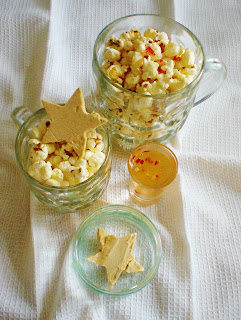 |
| Rich with toasted spices and thick with cream and almonds this curry goes beautifully with the butter yellow pilau rice. |
Curry is one of my absolutely favourite foods, I cannot get enough of the rich spices and creamy sauces and though not entirely authentic, this is my recipe for an very delicious chicken curry.
I like to serve it up with buttery pilau rice and a hot baked naan, I didn't make my own naan this time due to a store cupboard failure! But I'll be popping up the recipe later in the week if you fancy doing the whole hog from scratch.
Recipe:
Serves 2
The curry:
2 chicken breasts
1/2 lemon
150g natural yoghurt
3 cloves
1 tsp chili oil
salt and pepper
1 tsp oregano
1 tsp finely chopped garlic
3 cardamom pods
1 tsp freshly grated ginger
1 tsp ground Cinnamon
1 tsp coriander seeds
1 tsp cumin seeds
1 tsp garam masala
1 tsp paprika
1 tsp turmeric
1 small pot of double cream
3 tbsp ground almonds
1 tbsp flaked almonds
1 onion
The rice:
80g basmati rice per person, if making rice for more than 4 people double the quantity of spices)
knob of butter
1 onion
1 tsp turmeric
1 star anise
3 cardamom pods
salt and pepper
You need to marinate your chicken ideally overnight but for at least 8 hours to give it a good rich flavour and for the yoghurt to tenderise the meat. So we start with our marinade!
In a dry frying pan, toast the following of your spices; the cloves, cardamom pods, cumin and coriander seeds. Jiggle the pan until the seeds begin to pop and you can smell the spices wafting from the pan, tip the roasted spices into a pestle and mortar and grind to a fine powder. In a bowl large enough to mix up the chicken and yoghurt marinade, dollop in the yoghurt and your powdered toasted spices, also add in the chili oil, a good pinch of salt and pepper, oregano, ginger, garlic, Cinnamon, garam masala, paprika and turmeric. Mix the spices into to the yoghurt until you have a smooth and evenly orange coloured paste.
Chop your chicken into bite sized pieces then fold into the yoghurt, make sure the chicken is well coated and, as much as you can, push the chicken under the yoghurt so it is tucked underneath the marinade as much as possible. Cover the bowl with clingfilm and leave in the fridge for at least 8 hours but ideally over night.
When you are ready to cook the curry after the chicken has marinated, finely slice your onions and begin to fry them in a little oil in a large high walled frying pan. Fry the onions until they are golden brown, now pick out the chicken from the marinade and add it to the pan, but do not throw away the remaining yoghurt. By picking out the chicken and shaking off the marinade it gives the chicken a chance to fry and colour rather than 'poach' on the sauce, it ultimately gives the curry another dimension in flavour.
When all the chicken is browned, pour in the rest of the marinate and allow to bubble and reduce to a very thick paste. Now pour in your cream and sprinkle over the ground almonds, reduce to a very low heat and leave to cook out into to a golden, creamy sauce. If you find your curry become too thick add a little water to loosen it, the curry will be cooked after about 20 mins, I cook my rice during this simmering time so it's all ready at the same time.
To make the rice, begin by chopping the onion into a very fine dice, fry this in a saucepan in the butter for a few minutes until it has softened a little. Now add in your cardamom pods, star anise and turmeric, the butter and onions should turn a bright sunshine yellow, coloured by the turmeric. Fry this together for another few minutes until you can smell the spices in the air. Pour in your rice turn it in the coloured butter and fry for a further 2 mins, now tip in freshly boiled water so that it covers the rice by about 2 cms.
Turn the heat down under the rice and leave to cook, you need to keep an eye on it as the water will cook down until the rice begins to fry, you want this to happen, When you can see that the water is starting to sink below the surface of the cooked rice check to make sure the rice is tender but with a little bite left in it, turn the heat up under the pan and fry the rest of the water away, keeping the rice moving so it doesn't stick to the pan and burn. When all the water has gone add a little more butter to the pan and give the rice a good, hot sizzle to finish it off.
Serve up the curry with a sprinkle of flaked almonds on tops for texture and a pile of glistening rice beside it, smother a naan with butter and grill for a few moments before tucking it in next to your indulgent curry!












